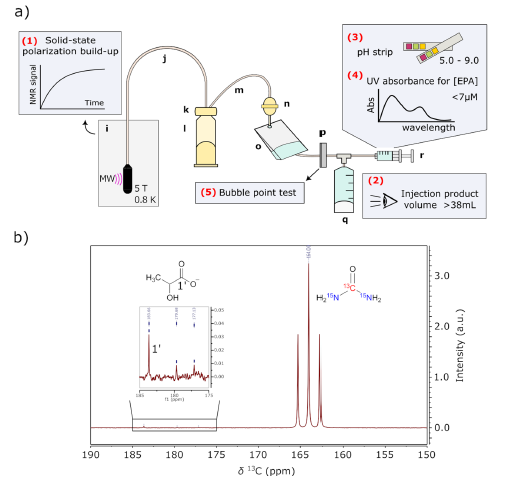643. Translation of hyperpolarized [¹³C,¹⁵N₂] urea MRI for novel human brain perfusion studies
Yaewon Kim, Hsin-Yu Chen, TannerNickles, Illia Shkliar, DuyDang, James Slater, Charlie Wang, Jeremy W. Gordon, Chou T. Tan, Chris Suszczynski, Sri Maddali, AdamGaunt, RuiChen, Javier Villanueva-Meyer, Duan Xu, Peder E. Z. Larson, JohnKurhanewicz, Robert A. Bok, Susan Chang, Daniel B. Vigneron, npjImaging, (2025), DOI: 10.1038/s44303-025-00073-3
This study developed a new approach to produce sterile, hyperpolarized [13C,15N2]urea as a novel molecular imaging probe and applied it for first-ever healthy brain volunteer studies. Hyperpolarized [13C,15N2]urea, as a small, metabolically inert molecule, offers significant advantages for perfusion imaging due to its endogenous nature and excellent safety profile. The developed methods achieved a hyperpolarized [13C,15N2]urea solution (132 ± 6 mM) with 27.4 ± 5.6% polarization and a T1 = 50.4 ± 0.2 s. In healthy brain volunteer studies, high-resolution 13C imaging captured blood flow with a spatial resolution of 7.76 × 7.76 × 15 (or 10)mm3 over ~1 min following hyperpolarized [13C,15N2] urea injection, visualizing detailed vascular structures. Time-to-peak and centroid analyses showed consistent arterial and venous signal patterns across subjects. Findings suggest hyperpolarized [13C,15N2]urea may have applications beyond brain imaging, including the non-invasive perfusion assessment in various organs, cancer microenvironment, and renal function, paving the way for clinical translation.
